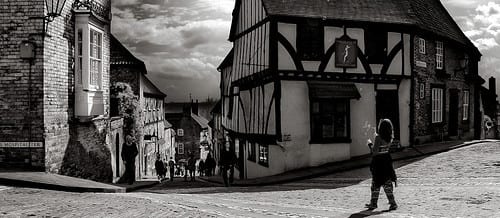Over the last week our overall concept has slightly altered. Due to the lack of response from the school we emailed, it not only forced us to changed either the school or the idea all together. After a long discussion we decided that it was too much to find the time to gain access and record the audio, plus we we didn’t know of any children in this area that we could test run it on, which left us taking a huge risk. Therefore we scrapped the consept of children’s perceptions and focused on all ages. By focusing on all ages we realised it linked back to our original idea of the many layers of perceptions that surround the cathedral. The route we had picked out for our tour also influenced our process as its an almost circular route with the starting and finishing point at the same place. This then made us think of a pilgrimage and the journeys of discovery the partisipants embarked upon. Within Phil Couineau’s book The Art of Pilgrimage, Hudson Smith stated that ‘The object of a pilgrimage is not to rest and recreation – to get away from it all. To set out on a pilgrimage is to throw down a challenge to everyday life’ (Smith, 1998). This made me really think about what is is we were going to ask the participants to do. After Conan’s feedback we scrapped the activities and so we have just an audio to make such an impact. However, with a strong audio tour we would be able to challenge them to open their minds. To develop an appreciation for the growth of the imagination. To understand that one object/ site can have many facts and truths through individual understanding. One particular quote that caught my eye was one of Balloc’s absolutisms, ‘The volume and depth and intensity of the world is something that only those on foot will ever experience’ (Belloc, 1904). Hopefully at the end of their walk, when they arrive back at the place they began, they may feel more aware of the site, themselves, the world, and possibly a change of thoughts may have occurred along the way. To achieve this we researched into the history of lincolnshire pilgrimages and discovered that Lincoln Cathedral was one of the most popular pilgrimage points in England. The 1536 pilgrimage from St Jame’s church in Louth to the Lincoln Cathedral had over 40,000 participants by the time it arrived in lincolnshire. Pilgrims therefore have a significant history with the cathedral (as a statue of a pilgrim is calved on the west side of the cathedral), and we are really interested in incorporating it into our piece somehow. The scallop shell is significant regarding pilgrims and we were planning on giving each participant one on a piece of sting to hang around their necks, like they did in the original religious pilgrims.
Finally here are a few quotes that made me think:
‘While on pilgrimage people think with landscape, rather than only about it’ (MacFarlane, 2012)
‘It is the material culture of the city, rather than the psyche, that provides the shared collective spaces where consciousness and the unconscious, past and present, meet.’ (Buse, 2005,52)
‘It is along paths too, that people grow into a knowledge of the world around them, and describe this world in the stories that they tell.’ (Ignold, 2007, 2)
‘Economic, political and cultural social relations, each full of power and with internal structures of domination and subordination, stretched out over the planet at every different level, from the household to the local area to the international. It is from that perspective that it is possible to envisage an alternative interpretation of place. In this interpretation, what gives a place its specificity is not some long internalized history but the fact that it is constructed out of a particular constellation of social relations, meeting and weaving together at a particular locus. If one moves in from the satellite towards the globe, holding all those networks of social relations and movements and communications in one’s head, then each ‘place’ can be seen as a particular, unique, point of their intersection. It is, indeed, a meeting place. Instead then, of thinking of places as areas with boundaries around, they can be imagined as articulated moments in networks of social relations and understandings, but where a large proportion of those relations, experiences and understandings are constructed on a far larger scale than what we happen to define for that moment as the place itself, whether that be a street, or a region or even a continent. And this in turn allows a sense of place which is extroverted, which includes a conscious- ness of its links with the wider world, which integrates in a positive way the global and the local.’ (Massey, 1994, 154-156)
Buse, P., Hirschkop, K., McCraken, S., Taithe, B. (2005) Benjamin’s Arcades. An UnGuided Tour. Manchester: Manchester University Press.
Ingold, T. (2007) Lines: A brief History. Oxon: Routledge.
MacFarlane, R. (2012) Rites of way: Behind the pilgrimage revival. [online] London: The Guardian. Available from http://www.theguardian.com/books/2012/jun/15/rites-of-way-pilgrimage-walks [Accessed 23 March 2014].
Massey, D. (1994) Space, Place and Gender. Minneapolis: University of Minnesota Press.
Smith, H. (1998) Forward in The Art of Pilgrimage: The Seeker’s Guide to Making Travel Sacred. California: Conari Press.
